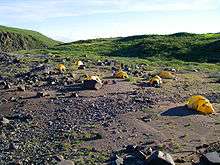Bloody Falls

Bloody Falls (or Bloody Fall, or Kogluktok, meaning "it flows rapidly" or "spurts like a cut artery" in Inuktitut)[1] is a waterfall in the Kugluk/Bloody Falls Territorial Park in Nunavut, Canada. It was the site of the Bloody Falls Massacre in 1771 and the murder of two priests by Copper Inuit Uloqsaq and Sinnisiak in 1913.[2]
The nearest hamlet, Kugluktuk, Nunavut, is 15.8 km (9.8 mi) away.

Historically, this area was occupied by the Kogluktogmiut subgroup of Copper Inuit.[3]
In 1978, the portion of the Territorial Park northwest of the Coppermine River was designated the Bloody Falls National Historic Site of Canada, as the archaeological remains of pre-contact hunting and fishing sites in the area form a record of the presence of Pre-Dorset, Thule, First Nation and Inuit peoples over the last 3000 years.[4]
References
| Wikimedia Commons has media related to Bloody Falls. |
- ↑ "Bloody Fall, Nunavut, Canada". travelingluck.com. Retrieved 2008-08-25.
- ↑ Stern, Pamela (2004). Historical dictionary of the Inuit. Lanham: Scarecrow Press. p. 149. ISBN 0-8108-5058-3. Retrieved January 26, 2011.
- ↑ Stefansson, Vilhjalmur (1914). The Stefánsson-Anderson Arctic Expedition of the American Museum: Preliminary Ethnological Report. New York: The Trustees of the American Museum. p. 27. OCLC 13626409.
- ↑ Bloody Falls National Historic Site of Canada. Directory of Federal Heritage Designations. Parks Canada. Retrieved 29 October 2013.
Coordinates: 67°44′37″N 115°22′03″W / 67.74361°N 115.36750°W